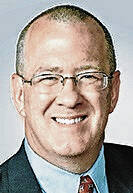Post-pandemic America is in the midst of significant disruption to work and living options. People are on the move and face enormous choice in how and where to work.
The Midwest should be a big winner in this mad scramble. Thus far, we have not been. Population growth remains sluggish, and the composition of interstate migration isn’t leaving the Midwest with a more educated workforce.
The most likely reason for this is we are chasing past economic glories rather than pursuing economic opportunities of the future. More than 100% of the net migration in the Midwest is between cities, or from rural to urban places. So, the discussion is necessarily centered on the forces that make cities; agglomerations or local productivity and quality of life.
Urban places have an advantage in worker productivity, a phenomenon economists call agglomerations. The effects are shockingly large. At the individual worker level, in the same occupation and industry, the effect is about 20%. That means the urban worker can produce as much in four days as the as the rural worker does in five days.
But, there is also an industry and occupational composition effect. More productive industries and more productive workers tend to locate in cities.
Historically – say for the last 6,000 years – cities have been the destination for opportunity. Rural places might have jobs in manufacturing or utilities, but cities held broad opportunity for most families. So, this productivity benefit is a force that attracts people to cities, but there are also forces that push them away.
The rush of people and businesses to cities increases the price of land and housing and puts demands on infrastructure. Roads are more congested and housing is necessarily smaller.
So, cities are more expensive. Also, because they are rich places, all Midwestern states and the federal government shift tax dollars from urban to rural places. These forces push people away from more-urbanized to less-urbanized places.
However, households aren’t simply income-maximizing calculators. They choose places to live and work based on a large and diverse set of preferences. These are well known to economists, and include such obvious factors as warmer January temperatures, cooler Julys, some natural elevation change, miles of shoreline on oceans, lakes or rivers, and number of sunny days. The Midwest does well on some of these quality-of-life measures.
Households also prefer diverse choices of restaurants and retail, recreational activities, fitness centers, other gathering places, strong congregations, and ethnic and racial diversity. Economists believe that these amenities follow people. So, faster-growing locations tend to attract more, and different, people who will spend money on restaurants, fitness centers and the like, which are quality-of-life amenities.
I’m speaking about the average migrating family, not everyone. Some folks don’t care about weather or the availability of a local church or the presence of a fitness center. Folks who don’t care about local amenities don’t typically migrate.
Government plays a very limited role in the mix of natural amenities, as well as those provided by the private sector. State and local governments can improve environmental protections and make it easy for new businesses to start. The Midwest’s legacy of manufacturing has not left us with pristine air, lakes or rivers. But, in most places it is easy to start a business or open up a shop or service. That is a real comparative advantage that should be more forcefully promoted.
However, in study after study, the big draws to a local area are those amenities provided by local government. School quality plays a larger role in quality-of-life measures than all the natural amenities and all the privately produced amenities combined. Likewise, local crime rates play a key role in the decisions people make about where they live.
It is hard to disentangle the specific local government factors that play such a large role in the migration decisions of households. The reason for that is maybe best captured by a riff on Tolstoy’s famous first line: All happy places are alike; each unhappy place is unhappy in its own way.
Places with good schools also typically have low crime, clean, well-maintained streets, enforced housing codes and other measures of good government. It might be impossible to disentangle all these things using statistical tools that identify such advantages as average January high temperatures and the number of fitness centers in a city.
We do know that families have much better tools to distinguish between places. There are dozens of community rating services online, as well as housing information available on Multiple Listing Services. Since the No Child Left Behind legislation was passed, all schools have real measures of performance that are publicly available. These are driving population change.
Here in Indiana, in the last five years before COVID-19, the A-graded school corporations saw average enrollment growth of 2.2 percent, Bs lost 1.5 percent, Cs lost 2.5 percent, Ds lost 9.9 percent and F-graded schools lost 22.7 percent of their enrollment.
The point of all this is that households make trade-offs between the productivity benefits of locating in a particular city, and the available amenities — with an overwhelming focus on local government quality.
The Midwest does fine on the productivity measures. Chicago, Indianapolis, Lima, Ohio, Elkhart-Goshen, Madison, Wisconsin, Columbus, Indiana, and Bloomington, Illinois, are all in the top 10% of most productive metropolitan places in the country. The Midwest also has a big share of the least productive cities, including Muncie, which is in the bottom 10% in productivity.
High-productivity places need fewer amenities to attract new residents. High-amenity locations, like Indianapolis, typically grow quickly. Low-productivity places need high levels of amenities to draw new residents. This leads us to the central point about what is happening with slow growth across the Midwest during this post-COVID period.
The real problem with the Midwest is that there are very few high-productivity, high-amenity cities, but there are abundant low-productivity, low-amenity cities. The forces that push people to Midwest cities is weaker than the forces that push them outside the region.
The key to remedying weaknesses in either productivity or local amenities are held primarily by state and local governments — educational opportunity, low crime, clean streets are the catalysts for attracting people.
Michael J. Hicks is the director of the Center for Business and Economic Research and an associate professor of economics in the Miller College of Business at Ball State University. Send comments to [email protected].





